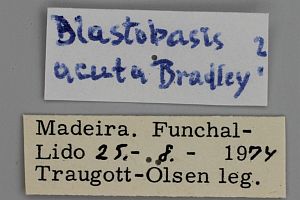1. Lebendfotos
1.1. Falter
3. Biologie
3.1. Nahrung der Raupe
Nach den Ausführungen von Amsel (1952: 71-72) muss die Raupe dieser Art hochgradig polyphag sein; er erhielt seine Falter aus Raupen, die in Marokko an Weintrauben (Vitis vinifera, Hülsen von Erbsen (Pisum sativum) und an "angefressenem Holz von Prunus persica, Populus hickeliana und Olea europaea" gefunden wurden.
4. Weitere Informationen
4.1. Andere Kombinationen
- Holcocera maroccanella (Amsel, 1952)
4.2. Synonyme
- Blastobasis acuta Bradley, 1958
4.3. Faunistik
B. maroccanella wurde aus Marokko beschrieben. Oben gezeigte Bilder stammen von den Azoren, Madeira und der Algarve in Portugal. Nach der Fauna Europaea [Fauna Europaea, last update 29 August 2013, version 2.6.2] kommt die Art im Gebiet auf Madeira und den Azoren sowie in Portugal und Spanien vor. Dort war sie bisher nur vom Süden der Iberischen Halbinsel bekannt (Algarve, Provinz Málaga), doch Revilla & Gastón (2019: 109) können sie erstmals auch ganz aus dem Norden Spaniens melden: "Vizcaya: Berango, 1♂, a 20 m, 7-III-2011; 1♂, 2-III-2019; 1♂, 25-VII-2018; 1♂, 6-V-2014; 2♂♂, 29-VII-2018; 1♂, 1-VIII-2018; 2♂♂, 5-VIII-2017; 1♀, 16-IV-2019; 1♀, 19-V-2004, Tx. Revilla leg. y col."
[hantsmoths.org.uk (abgefragt 27. August 2021)] überraschen mit einem Falterfoto aus England ("Southsea, 25/07/2013, male, John Langmaid") und dem Vermerk: "Identified by John Langmaid from well over 100 B. adustella and ten B. vittata during the course of 2013 from his Southsea, Hampshire trap. Two, caught in July and November, proved to be B. maroccanella. The species is similar to a small, dark, indistinctly marked adustella or vittata; it is variable in size and markings, with a wingspan of 10-17mm. Records will need to be dissected to be acceptable." Nach Dickson, Langmaid & Thirlwell (2022) handelt es sich jedoch bei allen Britischen Exemplaren um B. vittata.
Landry et al. (2013: 32-33) berichten, dass die Art mittlerweile auch in die USA (Kalifornien) verschleppt wurde und dort mittlerweile etabliert ist: "This species, cited as Holcocera maroccanella, was first reported as present in Berkeley, California in 2002, without further details (Brown et al. 2010). Jerry Powell (E-Mail of 13 May 2013 to JFL) “first noticed it in 2000 (1 record) and 2002 (1 record), before it began to appear frequently — 2003 (4 records), 2005 (48 dates) and numerous per date in 2006. Since that time it has been the most frequent moth at his blacklight, present nearly every night year around, sometimes very numerous”. Barcoded specimens are from that locality."
(Autor: Erwin Rennwald, mit Ergänzung von Jürgen Rodeland)
4.4. Typenmaterial
Amsel (1952: 71-72): „Fundort : Bessabès (Zucht-Nr. 3461), Meknes (Zucht-Nr. 3376), Nekhila Marocco occid. (Zucht-Nr. 3595), Zäer (Zucht-Nr. 3495) 13. I., 22. II., 20. IV., 1950 ex. 1. Weintrauben (Vitis vinifera), Schoten von Pisum sativum und angefressenem Holz von Prunus persica, Populus hickeliana und Olea europaea.
4 ♂♂, 4 ♀♀.“
4.5. Literatur
- Erstbeschreibung: Amsel, H. G. (1952): Neue maroccanische Kleinschmetterlinge. — Bulletin de la Société des Sciences Naturelles du Maroc 31: 65–74.
- Dickson, R., Langmaid, J. R. & I. Thirlwell (2022): British Blastobasis maroccanella Amsel, 1952 are B. vittata (Wollaston, 1858). — The Entomologist's Record and Journal of Variation 134 (3): 116-120.
- Landry, J.-F., Nazari, V., Dewaard, J. R., Mutanen, M., Lopez-Vaamonde, C., Huemer, P. & P. D. N. Hebert (2013): Shared but overlooked: 30 species of Holarctic Microlepidoptera revealed by DNA barcodes and morphology. — Zootaxa 3749 (1): 1-93 [PDF www.mapress.com].
- Passos de Carvalho, J. & M.F.V. Corley (1995): Additions to the Lepidoptera of Algarve, Portugal (Insecta: Lepidoptera). — SHILAP Revista de Lepidopterología 23: 191–230. [Sekundärzitat]
- Revilla, Tx. & J. Gastón (2019): Contribución al conocimiento de la fauna de Microlepidoptera de España, con nuevos registros y otras citas de interés (Insecta: Lepidoptera). – Arquivos Entomolóxicos, 21: 107-114. [zum PDF-download auf unirioja.es] oder [zum PDF-Download auf researchgate.net]




![Einzelnachweis in Irland einschließlich Nordirland [Agassiz, Beavan & Heckford (2019)]](/res/img/flag/ie.gif)
![Fragliches Vorkommen in Frankreich (europäisches Territorium ohne Korsika) [Vandromme et al. (2020): Liste systématique et taxinomique des Lépidoptères de France]](/res/img/flag/fr.gif)
![Vorkommen in Spanien (Festland) [Vives Moreno A. (2014)]](/res/img/flag/es.gif)
![Vorkommen in Portugal (Festland) [Corley (2015): Lepidoptera of Continental Portugal]](/res/img/flag/pt.gif)
![Vorkommen auf Madeira [Aguiar & Karsholt (2006)]](/res/img/flag/pt-ma.png)
![Vorkommen auf den Azoren [Vieira & Karsholt (2010)]](/res/img/flag/pt-az.png)






